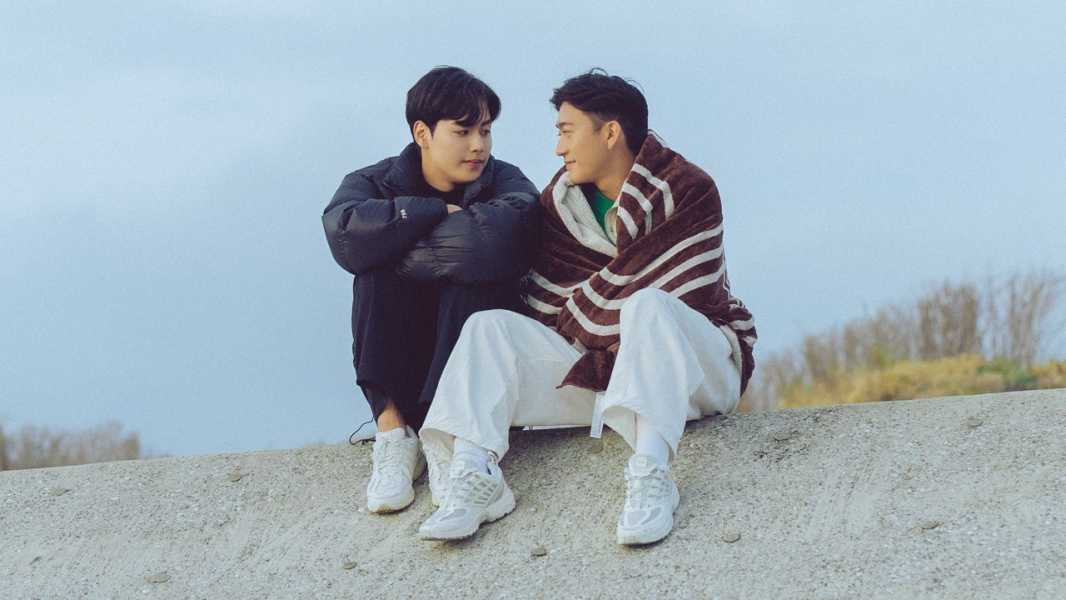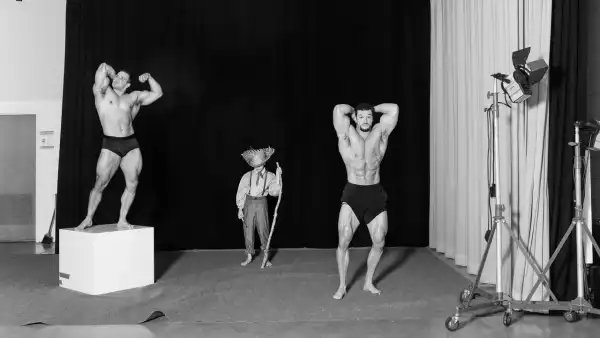
Save this storySave this storySave this storySave this story
In the early days, the boys like to play games. Rock, paper, scissors––loser has to admit his crush. Now, raise your hand if you want to work together. Write a letter to the person you like. The games are fun at first, but they’re never completely harmless; as one observer says, they come to be “a form of violence.”
That love and pain are two sides of the same coin is a precept embedded in Netflix’s new dating show “The Boyfriend.” Its concept is simple: nine cast members––described, inclusively, as “men who are attracted to other men”––live together for a month in sunny, coastal Tateyama City, in Japan. It lacks the Darwinian ethos of most other reality shows, as no one gets eliminated, and there are no emotional pyrotechnics or orchestrated humiliations. Instead, the boys have to run a coffee truck together, budget their groceries and meals, and, along the way, find friendship, or, possibly, the love of their lives.
There is the shy and photogenic Ryota; the hunky and shy Usak; the wholesome and shy Kazuto. There is Gensei, soft-spoken and sweet; Taeheon, practical and focussed; and Shun, brooding and quirky. Then there are the loud boys: warm and convivial Alan, of Brazilian and Japanese heritage; persistent and dynamic Dai; and, finally, as a late addition, brash and assertive Ikuo. The boys are young, stylish, and clear-eyed about what this experience is, and what it isn’t. “In this world, it’s very difficult to find a friend, let alone a best friend,” Kazuto says in an early episode. “Whether I find romance or not, I want to foster a strong connection with all of you so that our relationship can endure long after this show.”
“The Boyfriend” ’s clearest predecessor is “Terrace House” (2012-20), a hugely popular Japanese reality-TV show where one watches several strangers living in a house for several months. Relationships, romantic and platonic, emerge and fade organically. As in “Terrace House,” “The Boyfriend” cuts between footage of the contestants and a watch party of Japanese comedians, who interpret and react to the often subtle events. When Ryota makes a café mocha for Kazuto, in Episode 7, the party astutely observes that he had earlier done the same for Gensei; this is to be understood as a betrayal. The commentators embody vaguely familial archetypes––cool girl, nice aunt, grumpy dad, fun uncle. They come off as rowdy, supportive elders, lending comic relief to the house’s close quarters.
Yet “The Boyfriend” innovates on “Terrace House,” distilling that show’s languor into an effervescent concentrate. Drama comes from a clarified version of everyday conflict. Dialogue among the contestants unfolds with a koan-like quality; the cinematography is lush and reminiscent of Studio Ghibli films with gratuitous shots of nature, as if the boys were fauna native to Tateyama’s landscape. Betrayals are heart-stopping and novelesque. The show’s theme song, “Dazed & Confused,” by the Korean band Glen Check, sounds like liquefied twenty-tens angst poured over glossy synths. In the closeness of “The Boyfriend” ’s observations, I felt that I was watching a glacial David Attenborough-narrated nature documentary, but this one was about humans.
Some of the boys begin to date. Shun, a musician, and Dai, a university student, brew a tortured romance. Gensei develops a crush on Ryota. But some participants come to the show with ambitions outside of romance. Usak, a thirty-six-year-old go-go dancer, values becoming a clear and honest communicator almost as much as he values finding love. “Exposing my inner self to others,” Usak muses on one of his first confessionals at the house, “I’ve never had that experience. During my stay here, I’m hoping to be able to honestly express my feelings to others.”
Usak feels out of place among the group. When others play board games, he has to work out. His muscled physique and handsome looks intimidate the rest of the cast. They regard him with deference or, as one commentator puts it, almost “worship Usak like a god.” His diet is restrictive––or the opposite of that, depending on what you call having to drink a seventeen-hundred-gram chicken smoothie every day.
The chicken smoothie becomes a significant plot point in Episode 2. The boys are seated around a couch when young Dai sombrely brings up the budget. One pack of chicken costs about eight hundred yen, and Usak needs three of them to maintain his protein intake. Out of their six-thousand-yen daily budget, he says, about one-third of it is going to Usak’s chicken. Gensei says that he understands Usak’s need to maintain a routine for his work, but he also wants to be fair to the rest of the cast. The show cuts to a scene of Usak’s undulating torso under night-club lights, as if to remind us of the stakes of drastically reducing his protein intake. The boys could allocate a thousand to Usak’s chicken, Dai reasons, and the rest could go to feeding everyone else.
My language for humor fails to capture just how funny this is: the contrast between the seriousness of their demeanor and the surreality of a chicken smoothie; the bigness of Usak and the meekness of his acceptance. The financial hardship is, of course, simulated (later, they resolve to just make more money at the coffee shop to cover the difference), but this domestic skirmish sweetens the romantic drama, making each person feel more real.
Inevitably, the incident heightens Usak’s feelings of not fitting in. “Are both of you your true selves on the show, in this house?” he asks Ryota and Gensei, as they sit and sweat in the house’s back-yard sauna.
“Please feel free to be yourself,” Ryota tries to assure him.
“Don’t worry,” Gensei adds.
“At times,” Usak begins again, framed through the iridescence of the sauna window, “I’m not sure what my true self is.”
“The Boyfriend” proceeds from the premise that a dating show is an insanely artificial environment in which to date people. Still, such artificiality need not be a cause of despair but, rather, a special opportunity for introspection. The cast’s earnestness, as the watch party mentions, is “dazzling.” At the end of Episode 5, Usak abruptly announces that he is leaving. “It doesn’t matter if you’re staying here for love or friendship. I think there are things you can only say because it’s here,” he says. “I hope that all of you guys will cherish this opportunity to convey your feelings, share your thoughts, be happy.” His departure from the show feels like a death, eulogized in later episodes.
“Please eat the chicken breast, too,” he says tearfully, as everyone on the patio breaks into sobs.
Though the U.S. has its own new crop of gay dating television (special seasons of “Are You the One?,” “The Ultimatum,” etc.), what distinguishes “The Boyfriend” is its relative restraint. Part of this stems from Japanese culture. Another factor may be the show’s proximity to the genre of Boy’s Love media (“BL”), male-male dramas descended from Japanese yaoi romance fiction, which emerged in the nineteen-seventies. Unlike, say, bara, a gay art genre typically made for male consumption, yaoi is written and consumed mostly by women. BL is characterized by certain narrative tropes: A popular boy who lavishes his attention on the class underdog, a stand-in for the reader. He is usually not gay; his sexuality is you. This is fantasy––rarely do the universes of BL shows acknowledge a broader gay culture. But BL is an international phenomenon, with hundreds of films and TV dramas across China, Thailand, Korea, and Japan, as well as streaming platforms, such as Viki and GagaOOLala, which celebrate the genre. As much as I love BL, it sometimes seems like a vision of gay love that’s been stripped of the nuisance of gay men—and their attendant anxieties, neuroses, and unsavory desires.
“The Boyfriend” winks at BL but ultimately departs from the genre. In the first episode, the boys consider naming their coffee truck BL, for Boys’ Latte. Shun jokes that those who know, will know. (In Shun’s own romance, with Dai, where he channels a moody underclassman pursued by a persistent, athletic jock, he comes to resemble a BL character himself.) But, for the most part, the show doesn’t shy away from addressing the difficulties of actual gay life in Japan, where same-sex marriage is not yet legal.
Some of the contestants are the sons of traditional-minded families, and their appeals for advice are honest and touching. In Episode 8, the Korean designer Taeheon, who finds no romance on the show, asks the gay hive mind for advice on how to come out to his parents. “Our sexuality isn’t necessarily about sex but about our identities,” Durian Lollobrigida, a drag queen on the watch panel, says sagely. “You tell someone what kind of person you are, and, if they accept you for it, that can feel very self-affirming.”
Most mornings, after breakfast, the boys gather in the living room to await instruction from the iPad, which, via text, designates one boy who will get to choose another to work with that day. The two then drive down to the Tateyama shore and sell coffee to vacation-goers. Afterward, they have a little date. On their first day running the truck, Gensei and Ryota make about seventeen hundred yen, roughly the equivalent of eleven dollars.
Over time, Kazuto, a twenty-seven-year-old chef and the son of rice farmers from Niigata, emerges as a house favorite. Unable to inherit his family business because of his sexuality, he decides to create a restaurant that uses rice from his family farm and produce grown in his home town. Like Usak, he is seen as extravagantly attractive, but in a Confucian, good-son way rather than a raw-sex-appeal way.
Poor Kazuto is crushed by the weight of appeals from multiple romantic suitors. Both Ikuo and Alan claim it was love at first sight. Ryota finds him “adorable.” Usak says he’s his “type.” Kazuto squirms; he is “shocked” and “so surprised.” Confession, as much as we prize it, places an enormous burden on the object of affection. “The Boyfriend” revels in these minor provinces of love, and it is all the more thrilling for it. The pangs of dejection are as pleasurably depicted as the euphorics of an early connection. “What if I can’t handle what he says?” Dai asks when anticipating a difficult conversation with his crush. “I’m scared.” As the cast yearns, fears, and hopes, we do, too, and it feels like being slowly engulfed in a full-body fever.
The many colors of heartbreak are given pride of place. The emotional palette of the show is reflected in its soft, blue-washed hues and bright pops of light. Because the cast lives in such close proximity, romantic interactions are often muddled with platonic ones. Gensei encourages Ryota to express his feelings for Kazuto, even though Gensei himself has a crush on Ryota. For the audience, and surely for Gensei, this moment is tragic. But it also captures the bittersweet pleasure of witnessing your crush fall in love. Gensei affectionately observes Ryota, animated and wistful, knowing that love might not return to him.
As I watched the show, the concept of the boyfriend—the singular boyfriend evoked by the title—began to denature. I was giddy with the vicarious heat of talking to a crush, of being flayed by rejection. It seemed to be less about finding an actual boyfriend than about getting a schooling in vulnerability, bravery, and emotional openness. One commentator, in a later episode, goes so far as to suggest that the show is a “microcosm of society,” even a utopia: “They expressed their feelings, and, when they got hurt, someone who understood gave them solace. It was an example of how we should live.” On a particularly scenic date between two cast members, after one has gently rejected the other’s admission of love, both boys sit on a sandy rock as the sunset dyes the sky orange and blue. One of them, looking wistfully into the horizon, notices the cloudy streak of a plane, caught in the rays of the falling sun. “That’s so pretty,” he says. “It’s like a slow version of a shooting star.” ♦
Sourse: newyorker.com






